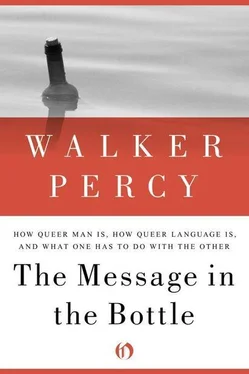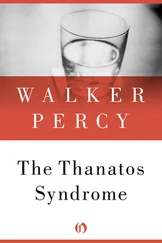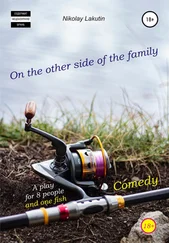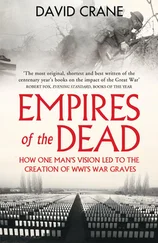As Mounier said, the person is not something one can study and provide for; he is something one struggles for. But unless he also struggles for himself, unless he knows that there is a struggle, he is going to be just what the planners think he is.
IN MISSISSIPPI, COIN RECORD players, which are manufactured by Seeburg, are commonly known to Negroes as seabirds.
During the Korean War, one way of saying that someone had been killed was to say that he had bought the farm.
I remember hunting as a boy in south Alabama with my father and brother and a Negro guide. At the edge of some woods we saw a wonderful bird. He flew as swift and straight as an arrow, then all of a sudden folded his wings and dropped like a stone into the woods. I asked what the bird was. The guide said it was a blue-dollar hawk. Later my father told me the Negroes had got it wrong: It was really a blue darter hawk. I can still remember my disappointment at the correction. What was so impressive about the bird was its dazzling speed and the effect of alternation of its wings, as if it were flying by a kind of oaring motion.
As a small boy of six or seven walking the streets of Cambridge I used often to pass little dead-end streets, each with its signpost which at its top read, say, Trowbridge Place or Irving Terrace, and underneath in letters of a different color and on a separate board, the following mysterious legend: Private Way Dangerous Passing. The legend meant of course merely that the City of Cambridge, since it neither built nor maintained the roadbed of this place or this terrace, would not be responsible for injury to life or property sustained through its use. But to me it meant something else. It meant that there was in passing across its mouth a clear and present danger which might, and especially at dusk, suddenly leap out and overcome me. Thus, to say the least of it, I had the regular experience of that heightened, that excited sense of being which we find in poetry, whenever I passed one of those signs.
Misreadings of poetry, as every reader must have found, often give examples of this plausibility of the opposite term. I had at one time a great admiration for that line of Rupert Brooke’s about
The keen
Impassioned beauty of a great machine,
a daring but successful image, it seemed to me, for that contrast between the appearance of effort and the appearance of certainty, between forces greater than human and control divine in its foreknowledge, which is what excites one about engines; they have the calm of beauty without its complacence, the strength of passion without its disorder. So it was a shock to me when I looked at one of the quotations of the line one is always seeing about, and found that the beauty was unpassioned , because machines, as all good nature poets know, have no hearts. I still think that a prosaic and intellectually shoddy adjective, but it is no doubt more intelligible than my emendation, and sketches the same group of feelings.
Four of the five examples given above are mistakes: misnamings, misunderstandings, or misrememberings. But they are mistakes which, in each case, have resulted in an authentic poetic experience — what Blackmur calls “that heightened, that excited sense of being”—an experience, moreover, which was notably absent before the mistake was made. I have included the fifth, the Korean War expression “He bought the farm,” not because it is a mistake but because I had made a mistake in including it. The expression had struck me as a most mysterious one, peculiarly potent in its laconic treatment of death as a business transaction. But then a kind Korean veteran told me that it may be laconic all right, but he didn’t see anything mysterious about it: The farm the G.I. was talking about was six feet of ground. This is probably obvious enough, but I have preserved this example of my own density as instructive in what follows.
It might be useful to look into the workings of these accidental stumblings into poetic meaning, because they exhibit in a striking fashion that particular feature of metaphor which has most troubled philosophers: that it is “wrong”—it asserts of one thing that it is something else — and further, that its beauty often seems proportionate to its wrongness or outlandishness. Not that the single linguistic metaphor represents the highest moment of the poetic imagination; it probably does not. Dante, as Allen Tate reminds us, uses very few linguistic metaphors. The “greatest thing by far” which Aristotle had in mind when he spoke of the mastery of the metaphor as a sign of genius may very well have been the sort of prolonged analogy which Dante did use, in which the action takes place among the common things of concrete experience and yet yields an analogy — by nothing so crude as an allegorization wherein one thing is designated as standing for another but by the very density and thingness of the action. As Tate puts it: “Nature offers the symbolic poet clearly denotable objects in depth and in the round, which yield the analogies to the higher syntheses.” Yet the fact remains that the linguistic metaphor is, for better or worse, more peculiarly accessible to the modern mind — it may indeed be a distinctive expression of modern sensibility. And it has the added advantage from my point of view of offering a concentrated field for investigation — here something very big happens in a very small place.
Metaphor has scandalized philosophers, including both scholastics and semioticists, because it seems to be wrong: It asserts an identity between two different things. And it is wrongest when it is most beautiful. It is those very figures of Shakespeare which eighteenth-century critics undertook to “correct” because they had so obviously gotten off the track logically and were sometimes even contradictory — it is just those figures which we now treasure most.
This element of outlandishness has resulted in philosophers washing their hands of beauty and literary men being glad that they have, in other words, in a divorce of beauty and ontology, with unhappy consequences to both. The difficulty has been that inquiries into the nature of metaphor have tended to be either literary or philosophical with neither side having much use for the other. The subject is divided into its formal and material aspects, with philosophers trying to arrive at the nature of metaphor by abstracting from all metaphors, beautiful and commonplace, and with critics paying attention to the particular devices by which a poet brings off his effects. Beauty, the importance attached to beauty, marks the parting of the ways. The philosopher attends to the formal structure of metaphor, asking such general questions as, What is the relation between metaphor and myth? Is metaphor an analogy of proper or improper proportionality? and in considering his thesis is notably insensitive to its beauties. In fact, the examples he chooses to dissect are almost invariably models of tastelessness, such as smiling meadow, leg of a table, John is a fox. One can’t help wondering, incidentally, if Aristotle’s famous examples of “a cup as the shield of Ares” and “a cup as the shield of Dionysius” didn’t sound like typical philosophers’ metaphors to contemporary poets. Literary men, on the other hand, once having caught sight of the beauty of metaphor, once having experienced what Barfield called “that old authentic thrill which binds a man to his library for life,” are constrained to deal with beauty alone, with the particular devices which evoke the beautiful, and let the rest go. If the theorist is insensitive to the beauty of metaphor, the critic is insensitive to its ontology. To the question, why is this beautiful? the latter will usually give a material answer, pointing to this or that effect which the poet has made use of. He is unsympathetic — and understandably so — to attempts to get hold of art by some larger schema, such as a philosophy of being — feeling in his bones that when the cold hand of theory reaches for beauty, it will succeed in grabbing everything except the beautiful.
Читать дальше












